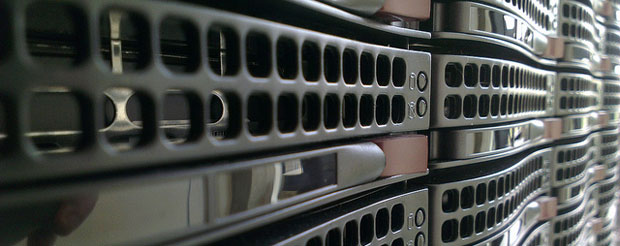- One Click Captcha (Wired) — Google’s new Captcha tech is just a checkbox: “I am not a robot”. Instead of depending upon the traditional distorted word test, Google’s “reCaptcha” examines cues every user unwittingly provides: IP addresses and cookies provide evidence that the user is the same friendly human Google remembers from elsewhere on the Web. And Shet says even the tiny movements a user’s mouse makes as it hovers and approaches a checkbox can help reveal an automated bot.
- The Responsive Enterprise: Embracing the Hacker Way (ACM) — Letting developers wander around without clear goals in the vastness of the software universe of all computable functions is one of the major reasons why projects fail, not because of lack of process or planning. I like all of this, although at times it can be a little like what I imagine it would be like if Cory Doctorow wrote a management textbook. (via Greg Linden)
- Pizza Hut Tests Ordering via Eye-Tracking — The digital menu shows diners a canvas of 20 toppings and builds their pizza, from one of 4,896 combinations, based on which toppings they looked at longest.
- How Browsers Get to Know You in Milliseconds (Andy Oram) — breaks down info exchange, data exchange, timing, even business relationships for ad auctions. Augment understanding of the user from third-party data (10 milliseconds). These third parties are the companies that accumulate information about our purchasing habits. The time allowed for them to return data is so short that they often can’t spare time for network transmission, and instead co-locate at the AppNexus server site. In fact, according to Magnusson, the founders of AppNexus created a cloud server before opening their exchange.
"performance" entries


Four short links: 4 December 2014
Click to Captcha, Managing Hackers, Easy Ordering, and Inside Ad Auctions

Signals from Velocity Europe 2014
From design processes to postmortem complexity, here are key insights from Velocity Europe 2014.
Practitioners and experts from the web operations and performance worlds came together in Barcelona, Spain for Velocity Europe 2014. We’ve gathered highlights and insights from the event below.
Managing performance is like herding cats
Aaron Rudger, senior product marketing manager at Keynote Systems, says bridging the communication gap between IT and the marketing and business sectors is a bit like herding cats. Successful communication requires a narrative that discusses performance in the context of key business metrics, such as user engagement, abandonment, impression count, and revenue.


Four short links: 13 October 2014
Angular Style, Consensus Filters, BASE Banks, and Browser Performance
- Angular JS Style Guide — I love style guides, to the point of having posted (I think) three for Angular. Reading other people’s style guides is like listening to them make-up after arguments: you learn what’s important to them, and what they regret.
- Consensus Filters — filtering out misreads and other errors to allow all agents, or robots, in the network to arrive at the same value asymptotically by only communicating with their neighbours.
- Why Banks are BASE not ACID — Consistency it turns out is not the Holy Grail. What trumps consistency is: Auditing, Risk Management, Availability.
- perfmap — front-end performance heatmap.

Scaling NoSQL databases: 5 tips for increasing performance
How NoSQL databases scale vertically and horizontally, and what you should consider when building a DB cluster.
Editor’s note: this post is a follow-up to a recent webcast, “Getting the Most Out of Your NoSQL DB,” by the post author, Alex Bordei.
As product manager for Bigstep’s Full Metal Cloud, I work with a lot of amazing technologies. Most of my work actually involves pushing applications to their limits. My mission is simple: make sure we get the highest performance possible out of each setup we test, then use that knowledge to constantly improve our services.
Here are some of the things I’ve learned along the way about how NoSQL databases scale vertically and horizontally, and what things you should consider when building a DB cluster. Some of these findings can be applied to RDBMS as well, so read on even if you’re still a devoted SQL fan. You might just get up to 60% more performance out of that database soon enough. Read more…

Signals from Velocity New York 2014
From the lure of work that matters to building your own device lab, here are key talks from Velocity New York 2014.
Practitioners and experts from the web operations and performance worlds came together in New York City this week for Velocity New York 2014. Below you’ll find a handful of keynotes and interviews from the event that we found particularly notable.
Mikey Dickerson: From Google to HealthCare.gov to the U.S. Digital Service
“These problems are fixable, these problems are important, but they require you to choose to work on them” — Mikey Dickerson looks back on what it took to fix HealthCare.gov and he reveals his reasons for joining the U.S. Digital Service.

How Flash changes the design of database storage engines
High-performing memory throws many traditional decisions overboard
Over the past decade, SSD drives (popularly known as Flash) have radically changed computing at both the consumer level — where USB sticks have effectively replaced CDs for transporting files — and the server level, where it offers a price/performance ratio radically different from both RAM and disk drives. But databases have just started to catch up during the past few years. Most still depend on internal data structures and storage management fine-tuned for spinning disks.
Citing price and performance, one author advised a wide range of database vendors to move to Flash. Certainly, a database administrator can speed up old databases just by swapping out disk drives and inserting Flash, but doing so captures just a sliver of the potential performance improvement promised by Flash. For this article, I asked several database experts — including representatives of Aerospike, Cassandra, FoundationDB, RethinkDB, and Tokutek — how Flash changes the design of storage engines for databases. The various ways these companies have responded to its promise in their database designs are instructive to readers designing applications and looking for the best storage solutions.

4 Steps to a culture of performance
Guidelines to maximize, allocate, and use resources strategically

Highway at night. Photo: Pixabay
Step one: Build your case
Before you can instill a culture of performance, you first need to demonstrate the value of strong web performance to your colleagues and superiors. To do that, you must build a case based on business standards that everyone can relate to, specifically by demonstrating the clear link between web performance and revenue. Calculate how much revenue you would lose if your site was down for hours, or even minutes. Ask how much time IT spends fixing problems when they could be working on other issues. Figure out what your competitors’ web performance is like and how yours compares (if it’s better, you have to keep up; if it’s worse, it’s an opportunity to take advantage of their weakness).
Read more…

It’s time for a web page diet
Site speed is essential to business success, yet many pages are getting bigger and slower.
 Earlier this year, I was researching online consumer preferences for a client and discovered, somewhat unsurprisingly, that people expect web sites to be fast and responsive, particularly when they’re shopping. What did surprised me, however, were findings in Radware’s “State of the Union Report Spring 2014” (registration required) that showed web sites, on average, were becoming bigger in bytes and slower in response time every year. In fact, the average Alexa 1000 web page has grown from around 780KB and 86 resources in 2011 to more than 1.4MB and 99 resources by the time of the early “2014 State of the Union Winter Report.”
Earlier this year, I was researching online consumer preferences for a client and discovered, somewhat unsurprisingly, that people expect web sites to be fast and responsive, particularly when they’re shopping. What did surprised me, however, were findings in Radware’s “State of the Union Report Spring 2014” (registration required) that showed web sites, on average, were becoming bigger in bytes and slower in response time every year. In fact, the average Alexa 1000 web page has grown from around 780KB and 86 resources in 2011 to more than 1.4MB and 99 resources by the time of the early “2014 State of the Union Winter Report.”
As an experiment, I measured the resources loaded for Amazon.com on my own computer: 2.6MB loaded with 252 requests!
This seemed so odd. Faster is more profitable, yet companies were actually building fatter and slower web sites. What was behind all these bytes? Had web development become so sophisticated that all the technology would bust the seams of the browser window? Read more…

Roll-your-own database architecture
Making the case for blended architectures in the rapidly evolving universe of advanced analytics.
Two years ago, most of the conversations around big data had a futuristic, theoretical vibe. That vibe has been replaced with a gritty sense of practically. Today, when big data or some surrogate term arises in conversation, the talk is likely to focus not on “what if,” but on “how do we get it done?” and “what will it cost?”
Real-time big data analytics and the increasing need for applications capable of handling mixed read/write workloads — as well as transactions and analytics on “hot” data — are putting new pressures on traditional data management architectures.
What’s driving the need for change? There are several factors, including a new class of apps for personalizing the Internet, serving dynamic content, and creating rich user experiences. These apps are data driven, which means they essentially feed on deep data analytics. You’ll need a steady supply of activity history, insights, and transactions, plus the ability to combine historical analytics with hot analytics and read/write transactions. Read more…

Tailoring CSS for performance
Rethinking CSS delivery
In my last article, I demonstrated how improved performance and a lower PageSpeed Insights score were accomplished by removing unnecessary external JavaScript and CSS requests. YepNope was also used to manage the asynchronous loading of external requests.
After the improvements, I thought it was time to move on but PageSpeed Insights advised there was more work to do.


